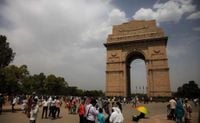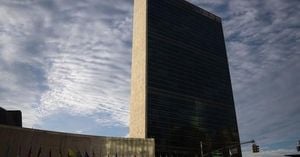Delhi and the National Capital Region (NCR) have been experiencing a notable shift in weather patterns over the past week, with intermittent heavy rainfall, fluctuating temperatures, and varying air quality levels shaping the daily lives of millions. From a cloudy Monday morning to a thunderous downpour on Wednesday evening, the region's weather has kept residents on their toes, while also offering a much-needed respite from the intense heat and pollution that often plague the capital.
On Monday, July 21, 2025, Delhi woke up to a cloudy sky and a minimum temperature settling at 27.2 degrees Celsius. The India Meteorological Department (IMD) forecasted rain throughout the day, with maximum temperatures expected to hover around 33 degrees Celsius. Morning humidity was notably high at 83 percent, contributing to the muggy atmosphere. Despite the damp conditions, the air quality was recorded as "satisfactory," with an Air Quality Index (AQI) reading of 77 at 9 AM, according to data from the Central Pollution Control Board (CPCB). This AQI level falls comfortably within the 51–100 range, which indicates satisfactory air quality, a welcome relief for a city often battling severe pollution.
Tuesday, July 22, 2025, brought more dynamic weather to Delhi. The city saw rain lash the capital in the morning, causing waterlogging in the southern and southwestern areas. Temperatures ranged from a minimum of 26 degrees Celsius to a maximum expected around 35 degrees Celsius, with relative humidity remaining high at 83 percent as measured at 8:30 AM. The IMD predicted rain accompanied by thunderstorms, signaling a continuation of the monsoon's vigorous presence. However, the air quality dipped slightly, registering in the "moderate" category with an AQI of 103. According to the CPCB’s standards, an AQI between 101 and 200 is considered moderate, indicating that air pollution levels were higher than the previous day but still not at levels considered poor or hazardous.
Then came Wednesday evening, July 23, 2025, when Delhi and the NCR faced a sudden and heavy downpour accompanied by thunder and lightning. This intense rainfall led to widespread waterlogging across many parts of the city, further disrupting traffic and complicating the daily commute for residents. The IMD issued an orange alert for the region, signaling moderate to heavy rain expected in certain areas of the capital. Temperatures on this day were forecasted to reach a maximum of around 35 degrees Celsius, with minimums dropping to about 24 degrees Celsius, offering a cooling break from the recent heat waves.
Humidity levels on Wednesday started high at 81 percent at 8:30 AM but eased to 58 percent by 5:30 PM. This shift in moisture content in the air, combined with the rainfall, helped maintain a satisfactory air quality level across Delhi, with the AQI recorded at 81 as of 4 PM—still within the satisfactory range. In fact, Delhi has maintained air quality in this satisfactory bracket for 14 consecutive days, a rare and commendable streak for a city frequently challenged by pollution.
The regional weather department also forecasted continued moderate rainfall with thunderstorms and lightning not only in Delhi but also in surrounding areas. These include several towns across Haryana, such as Rajaund, Panipat, Sonipat, Tosham, Rohtak, Bhiwani, Charkhi Dadri, Sohna, Rewari, Narnaul, and Nuh. In Uttar Pradesh and Rajasthan, places like Bijnaur, Baghpat, Meerut, Modinagar, Pilakhua, Hapur, Bulandshahar, and Bhiwadi were also expected to receive moderate rainfall. This widespread precipitation is a typical feature of the monsoon season but its intensity and timing have significant impacts on urban life and infrastructure in the NCR.
Residents have been advised to stay informed about the evolving weather conditions and to avoid flood-prone routes, especially during heavy rain spells. The combination of waterlogging and traffic disruptions makes commuting challenging, and safety precautions are strongly recommended. The IMD and local authorities continue to monitor the situation closely, issuing alerts and advisories to help citizens navigate the monsoon's challenges.
Beyond the immediate weather, Delhi's air quality has been a persistent concern for years. The city's recent achievement of maintaining a satisfactory AQI for two straight weeks is notable. This improvement is partly attributed to the monsoon rains, which help clear airborne pollutants, and ongoing efforts by authorities to curb emissions. However, challenges remain, especially given the city's dense population and industrial activity.
The CPCB's AQI scale ranges from 0 to 500, with 0–50 considered good, 51–100 satisfactory, 101–200 moderate, 201–300 poor, 301–400 very poor, and 401–500 severe. Delhi's readings over the past days have hovered between satisfactory and moderate, reflecting a mixed but generally improved air quality scenario. The presence of rain and thunderstorms plays a crucial role in this improvement, as precipitation helps wash away particulate matter and other pollutants from the atmosphere.
Looking ahead, the weather forecast suggests that the region will continue to experience intermittent rainfall and thunderstorms for the next few days. Such weather patterns are typical during the monsoon season, which usually lasts from June to September in northern India. While the rains bring relief from heat and help improve air quality, they also pose challenges such as waterlogging, traffic snarls, and health risks associated with damp and humid conditions.
In the broader context, Delhi's struggle with air pollution has prompted innovative solutions and policy measures. For instance, the Delhi government has announced initiatives to incentivize technological innovations aimed at reducing pollution from heavy vehicles. A competition offering a top prize of ₹50 lakh aims to find retrofit solutions that can upgrade older trucks to meet the stringent BS-VI emission standards, reflecting a proactive approach to tackling vehicular pollution.
Moreover, scientific methods like cloud seeding have been discussed as potential tools to manage rainfall and mitigate water scarcity or hail damage, although these are complex and not without controversy. Studies have also highlighted that sectors such as shipping, aviation, and construction contribute significantly to nitrogen oxide emissions, often facing weaker legal controls compared to other sources like home heating or automobiles.
As Delhi navigates its monsoon season amidst these environmental and public health challenges, the interplay between weather, pollution, and urban life remains at the forefront of public discourse. The recent spells of rain and the accompanying improvement in air quality offer a glimpse of hope, but the city’s residents and policymakers alike know that sustained efforts are essential to ensure cleaner air and a healthier environment for all.
For now, Delhiites are advised to stay alert, plan their travel considering traffic and weather updates, and take necessary precautions during the rainy spells. The monsoon's arrival, while disruptive at times, is a vital natural phenomenon that brings much-needed balance to the region's climate and air quality.




